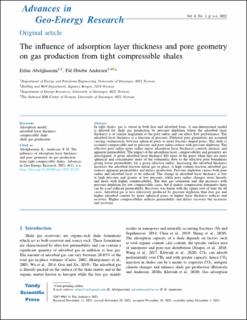| dc.contributor.author | Abolghasemi, Erfan | |
| dc.contributor.author | Andersen, Pål Østebø | |
| dc.date.accessioned | 2021-12-22T11:52:29Z | |
| dc.date.available | 2021-12-22T11:52:29Z | |
| dc.date.created | 2021-11-22T05:36:08Z | |
| dc.date.issued | 2021-12 | |
| dc.identifier.citation | Abolghasemi, E., Andersen, P.Ø. (2022) The Influence of Adsorption Layer Thickness and Pore Geometry on Gas Production from Tight Compressible Shales. Advances in Geo-Energy Research, 6(1) | en_US |
| dc.identifier.issn | 2207-9963 | |
| dc.identifier.uri | https://hdl.handle.net/11250/2835378 | |
| dc.description.abstract | In tight shales, gas is stored in both free and adsorbed form. A one-dimensional model is derived for shale gas production by pressure depletion where the adsorbed layer thickness is of similar magnitude as the pore radius and can affect flow performance. The adsorbed layer thickness is a function of pressure. Different pore geometries are assumed varying continuously between spherical pores to more fracture shaped pores. The shale is assumed compressible and its porosity and pore radius reduce with pressure depletion. The effective pore radius (pore radius minus adsorption layer thickness) controls intrinsic and apparent permeability. The impact of the adsorption layer, compressibility and geometry are investigated. A given adsorbed layer thickness fills more of the pores when they are more spherical and concentrates more of the volumetric flow to the effective pore boundaries giving lower permeability for a given effective radius. Increasing the adsorbed thickness increases the adsorbed fraction initial gas in place. A high volume fraction adsorbed gas reduces apparent permeability and delays production. Pressure depletion causes both pore radius and adsorbed layer to be reduced. The change in adsorbed layer thickness is low at high pressure and greater at low pressure, while pore radius changes more linearly and more with higher compressibility. The free gas saturation and slip increases with pressure depletion for low compressible cases, but if matrix compression dominates there can be a net reduced permeability. Recovery was linear with the square root of time for all cases. Adsorbed gas is less effectively produced by pressure depletion than free gas and higher adsorbed content by more spherical pores or higher layer thickness reduces end recovery. Higher compressibility reduces permeability and delays recovery but increases end recovery. Higher compressibility reduces permeability and delays recovery but increases end recovery. | en_US |
| dc.language.iso | eng | en_US |
| dc.publisher | Yandy Scientific Press. | en_US |
| dc.rights | Attribution-NonCommercial-NoDerivatives 4.0 Internasjonal | * |
| dc.rights.uri | http://creativecommons.org/licenses/by-nc-nd/4.0/deed.no | * |
| dc.subject | gass | en_US |
| dc.subject | adsorpsjon | en_US |
| dc.title | The Influence of Adsorption Layer Thickness and Pore Geometry on Gas Production from Tight Compressible Shales | en_US |
| dc.type | Peer reviewed | en_US |
| dc.type | Journal article | en_US |
| dc.description.version | publishedVersion | en_US |
| dc.rights.holder | © 2021 The Author(s). | en_US |
| dc.subject.nsi | VDP::Teknologi: 500::Berg‑ og petroleumsfag: 510 | en_US |
| dc.source.volume | 6 | en_US |
| dc.source.journal | Advances in Geo-Energy Research | en_US |
| dc.source.issue | 1 | en_US |
| dc.identifier.doi | 10.46690/ager.2022.01.02 | |
| dc.identifier.cristin | 1957040 | |
| dc.relation.project | Norges forskningsråd: 230303 | en_US |
| cristin.ispublished | true | |
| cristin.fulltext | postprint | |
| cristin.fulltext | original | |
| cristin.qualitycode | 1 | |

